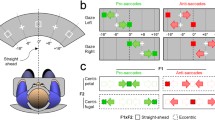Abstract.
In previous studies of saccadic eye movement reaction time, the manipulation of initial eye position revealed a behavioral bias that facilitates the initiation of movements towards the central orbital position. An interesting hypothesis for this re-centering bias suggests that it reflects a visuo-motor optimizing strategy, rather than peripheral muscular constraints. Given that the range of positions that the eyes can take in the orbits delimits the extent of visual exploration by head-fixed subjects, keeping the eyes centered in the orbits may indeed permit flexible orienting responses to engaging stimuli. To investigate the influence of initial eye position on central processes such as saccade selection and initiation, we examined the activity of saccade-related neurons in the primate superior colliculus (SC). Using a simple reaction time paradigm wherein an initially fixated visual stimulus varying in position was extinguished 200 ms before the presentation of a saccadic target, we studied the relationship between initial eye position and neuronal activation in advance of saccade initiation. We found that the magnitude of the early activity of SC neurons, especially during the immediate pre-target period that followed the fixation stimulus disappearance, was correlated with changes in initial eye position. For the great majority of neurons, the pre-target activity increased with changes in initial eye position in the direction opposite to their movement fields, and it was also strongly correlated with the concomitant reduction in reaction time of centripetal saccades directed within their movement fields. Taking into account the correlation with saccadic reaction time, the relationship between neuronal activity and initial eye position remained significant. These results suggest that eye-position-dependent changes in the excitability of SC neurons could represent the neural substrate underlying a re-centering bias in saccade regulation. More generally, the low frequency SC pre-target activity could use eccentric eye position signals to regulate both when and which saccades are produced by promoting the emergence of a high frequency burst of activity that can act as a saccadic command. However, only saccades initiated within ~200 ms of target presentation were associated with SC pre-target activity. This eye-dependent pre-target activation mechanism therefore appears to be restricted to the initiation of saccades with relatively short reaction times, which specifically require the integrity of the SC.
Similar content being viewed by others
Author information
Authors and Affiliations
Additional information
Electronic Publication
Rights and permissions
About this article
Cite this article
Paré, M., Munoz, D. Expression of a re-centering bias in saccade regulation by superior colliculus neurons. Exp Brain Res 137, 354–368 (2001). https://doi.org/10.1007/s002210000647
Received:
Accepted:
Issue Date:
DOI: https://doi.org/10.1007/s002210000647




